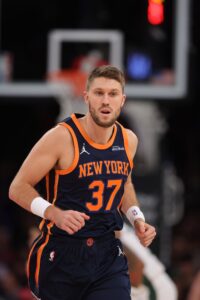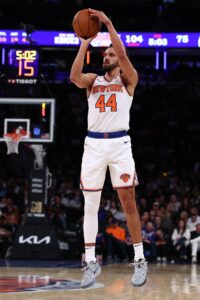7:19pm: The Knicks have officially signed Ryan and waived Buie, according to the team’s PR department (Twitter links).
 3:17pm: The Knicks intend to re-sign Matt Ryan to a two-way contract after he clears waivers, sources tell Fred Katz and James L. Edwards III of The Athletic (Twitter link). Ryan was cut from the standard roster on Sunday, so he’ll officially become a free agent at 5:00 pm ET today.
3:17pm: The Knicks intend to re-sign Matt Ryan to a two-way contract after he clears waivers, sources tell Fred Katz and James L. Edwards III of The Athletic (Twitter link). Ryan was cut from the standard roster on Sunday, so he’ll officially become a free agent at 5:00 pm ET today.
New York will waive two-way player Boo Buie in order to create a spot for Ryan, according to Katz and Edwards.
Ryan, 27, signed a non-guaranteed minimum-salary contract with the Knicks in November when they needed to add two players to their roster to get to the required minimum of 14. Ariel Hukporti, who had been on a two-way deal, was promoted to the standard roster at the same time Ryan was signed to get New York back to 14 players.
Known as a sharpshooter, Ryan has played for the Celtics, Lakers, Timberwolves, and Pelicans since making his NBA debut in April 2022, but has struggled to earn regular playing time. That was the case again this fall with the Knicks, as he appeared in just nine games, scoring 15 total points in 45 minutes. While the sample size was small, he was unable to get his three-point shot going in those outings, making just 3-of-14 (21.4%).
Still, Ryan – who is in his fourth NBA season – is the type of plug-and-play veteran capable of contributing in a pinch, so after cutting him to make room on the standard roster for Landry Shamet, the Knicks will bring him back at the expense of a developmental rookie in Buie.
An undrafted first-year pro out of Northwestern, Buie has yet to make his regular season NBA debut, having only played for the Westchester Knicks in the G League so far this season.
Assuming Ryan returns to the Knicks ahead of Wednesday’s Christmas Day game, he’ll be eligible to appear in up to a maximum of 32 more NBA games this season (a prorated portion of the usual 50-game limit).
 DECEMBER 22: The Knicks have agreed to a standard contract with guard
DECEMBER 22: The Knicks have agreed to a standard contract with guard